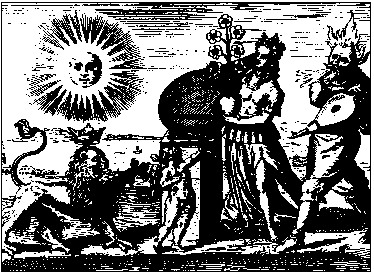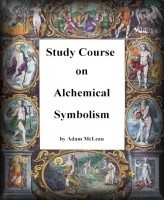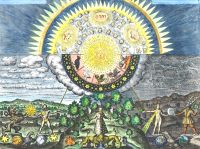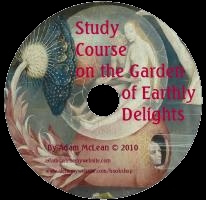|
|
Introduction to alchemical symbolismBack to Introduction.Alchemical manuscripts and books have always been illustrated with symbolic figures. There are, of course, simple signs used to notate various alchemical substances and processes, but the symbolism used in alchemy went much further than the mere use of special signs. Alchemy used symbols figuratively and allegorically, not just to represent an idea but to extend it and reveal its wider implications. For example, there is a considerable use of animal symbolism, the green lion, the black toad, the double headed-eagle, the serpent seizing its tail - various human figures, the old dying king, the white queen, the knight - as well as stylised forms of apparatus in which these figures interact. 
The above emblem is part of such a sequence being the fifth figure of the 'twelve keys of Basil Valentine'. We have to realise that lions appear four times in the sequence doing different things, the flower in three separate places, the burning head in two emblems. We cannot hope to unravel the meaning of this sequence until we can see it as a totality. Each individual symbol can appear with a different significance at different stages of the process, undergoing a sudden metamorphosis, or a more gradual purification. In studying such sequences of symbols it is best to put photocopies of the whole sequence up on a board or the wall of one's room, and try to find patterns or links between the individual symbols and emblems. Often there is an underlying geometric pattern which reveals how the symbolism works. The tableau presented in these emblems are not just a stylised way of bringing symbols together, but are often windows onto an ongoing drama. Sometimes it is not the individual symbols that are important, but what they are doing and how they are relating to the other symbolic elements of the emblem (for example, giving or receiving an object). The emblem sequences show the evolving alchemical process as a drama, a theatre of symbols, and one must sense the underlying process in order to understand the symbolic sequence. In this way alchemical figures are allegorical, and indeed we often find alchemists using complex allegories to explain their processes.
There is an extensive documentation of alchemical symbolism at another section of this site. |
Introduction Reading list Some quotations Frequently asked questions Common misconceptions Timeline The different ways of looking at alchemy -------
Proto-chemistrySymbolism Psychology allegorical journeys mysticism metaphysical historians of ideas  Study Courses
Study Courses Alchemical, astrological and emblematic art prints  Alchemy and art  Art books Series  Study course on Bosch's Garden of Earthly Delights New Hieronymus Bosch Website |